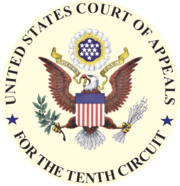Thompson v. Johnson County Community College
Appearance
| Thompson v. Johnson County Community College | |
|---|---|
 | |
| Court | United States Court of Appeals for the Tenth Circuit |
| Full case name | William E. Thompson v. Johnson County Community College, et al |
| Decided | March 25, 1997 |
| Citations | 108 F.3d 1388 (10th Cir. 1997) 116 Ed. Law Rep. 896 97 CJ C.A.R. 455 |
| Court membership | |
| Judges sitting | John Carbone Porfilio, Stephen H. Anderson, Mary Beck Briscoe |
Thompson v. Johnson County Community College, 108 F.3d 1388 (10th Cir. 1997)[1] is a decision by the United States Court of Appeals for the Tenth Circuit, involving the Johnson County Community College and its practice of giving workers no right to privacy in bathrooms or changing rooms. The college had used video to monitor the changing rooms, and since changing is a public function, there should be no expectation of privacy.[2][3]
Its importance includes rulings on the lack of expectation of privacy in public areas.[4]
References
[edit]- ^ Thompson v. Johnson County Community College, 108 F.3d 1388 (10th Cir. 1997).
- ^ Gold, Dana L. (2009). Law and Economics: Toward Social Justice. Emerald Group Publishing. ISBN 9781848553347. Retrieved October 2, 2013.
- ^ Franze, Laura (2012). "Privacy Issues in the Workplace". Texas Employment Law. Vol. 1. James Publishing. ISBN 9781580120265. Retrieved October 2, 2013.
- ^ Wilson, David B. "An Employer's Guide to Hidden Cameras in the Workplace" (PDF). Robinson & Cole Attorneys at Law. p. 5. Retrieved October 2, 2013.
External links
[edit]- Thompson v. Johnson County Community College at Open Jurist
- Video Monitoring information at WorkRights.org
